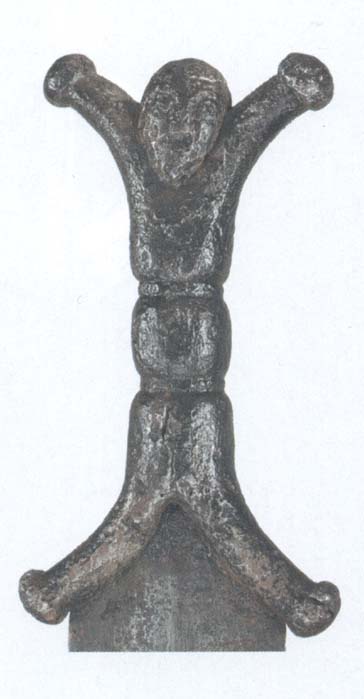Posts: 782 Location: Upstate New York
Sun 21 Jan, 2007 8:15 pm
A few anthropomorphic hilt sword lengths...
Hello all!
I have fewer sources for ancient weapons and armour than I do medieval, but I found a few dimensions for Celtic swords with anthropomorphic hilts. The few I found suggest that they were rather short, around twenty inches, but these shouldn't be taken as all-inclusive by any means. The hilts on a couple of these are more like "stylised" anthropomorphic hilts, without the human head, but they are related in form. I also found one at the web site for the Metropolitan Museum of Art.
The Diagram group book
Weapons: An International Encyclopedia from 5000 BC to 2000 AD shows a couple swords of this basic style in their drawings of European swords. Since they show the weapons with scale indicators my measurements are only approximates.
The first is an iron sword with a bronze hilt from Aquila, Italy, of circa 3rd century BC. I'm not positive that this is actually a Celtic sword, but it shares some features with the anthropomorphic hilt swords. The cross and pommel (using these terms loosely because the hilt could be made from one piece) both extend out into curved arms that end in round knobs, similar to the "arms and legs" of the anthropomorphic hilt swords. There is a flattened knob between the arms of the pommel where the head would be on a true anthropomorphic hilt. This sword has a leaf-shaped blade approximately 50 cm (20 in) in length. The overall length is approximately 61 cm (24 in).
The next sword shown in the Diagram book is a true Celtic sword with an anthropomorphic hilt. There is a head between the arms of the "pommel". The sword is a Gaulish iron sword with a bronze hilt from Aube, France, of circa 2nd century BC. The sword appears to be broken at the tip, but it's blade is approximately 45 cm (18 in) in length. The overall length is approximately 50 cm (20 in).
I found a Celtic sword with a "stylised" anthropomorphic hilt (or the precursor of the true anthropomorphic hilt) in Richard F. Burton's The Book of the Sword. It's from Hallstadt. It's "pommel" (again, the hilt is probably one piece) branches out into two curved arms that end in short "bars". The cross is shorter without knobs or bars. However, in general form, this one again looks similar to the true anthropomorphic hilt swords. (Maybe this one would be more precisely called an antenna hilt.) The sword's iron blade is leaf-shaped. Overall length for the sword is 40 cm (16 in). It's actually more of a dagger than a sword.
Here's the information about the sword from the Metropolitan Museum of Art (the photo is below):
| Metropolitan Museum of Art wrote: |
Sword, mid-1st century B.C.; Late Iron Age (La Tène)
Celtic
Iron blade, copper alloy hilt and scabbard; L. 19 3/4 in. (50 cm)
Rogers Fund, 1999 (1999.94a-d)
This sword offers eloquent testimony to the value that Celts placed on war and weaponry. Celtic artists often ingeniously integrated animal and human forms in the decoration of precious objects; here a warrior serves as the dramatic hilt for a double-edged sword. With its carefully defined features and finely drawn curls, the figure's head contrasts with the abstract form of the limbs and body. The arms and legs are V-shaped, terminating in round knobs, while the body is made up of three turned ring moldings. The scabbard, now amalgamated to the iron blade, still displays much of its original ornamentation in the form of three small hemispheres on the front upper end, a molding element at the tip, and an elaborate loop at the back for attaching the scabbard to a belt. Swords with an anthropoid hilt are characteristic of Celtic Europe in the first century B.C., with some fifty surviving from this period. Their inclusion in richly outfitted graves suggests that they were the valued property of aristocratic warriors. They may have been meant to enhance the power of the owner, or perhaps served as talismans in battle. |
Others may very well find many more examples. I thought I would post what I found, even if some were only roughly similar to the anthropomorphic hilt swords. It is interesting that the ones I found were much shorter than the 29 5/8 inch one that Chad posted (overall lengths of 24 inches, 20 inches, 16 inches, and 19 3/4 inches respectively).
I hope this helped!
Stay safe!
 Attachment: 10.39 KB
Attachment: 10.39 KB

Copyright The Metropolitan Museum of Art.



